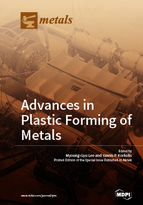Advances in Plastic Forming of Metals
A special issue of Metals (ISSN 2075-4701).
Deadline for manuscript submissions: closed (30 September 2017) | Viewed by 95496
Special Issue Editors
Interests: constitutive modeling for plasticity; multiscale modeling and simulation for structure materials; experimental mechanics; metal forming and shaping
Special Issues, Collections and Topics in MDPI journals
Interests: plasticity and constitutive modeling of materials; ductile fracture and formability. instabilities and wrinkling; forming of light-weight materials (e.g., high rate forming processes, sheet metal forming, tube hydroforming)
Special Issue Information
Dear Colleagues,
We would like to bring to your attention a Special Issue of Metals on "Advances in Plastic Forming of Metals". The forming of metals through plastic deformation is one of the most efficient and economical manufacturing processes available. In conjunction with their proven track record and their relatively low energy requirements, these processes are an indispensable part of our future. However, despite the vast accumulated know-how, research challenges remain, be they related to forming of new materials, e.g., for transportation lightweighting applications, or reducing the scrap or further enhancing the environmental friendliness.
The purpose of this Special Issue is to collect expert views and contributions on the current state-of-the-art, to highlight challenges and to offer solutions. The objectives are to enhance the understanding of metal deformation processes; discuss improved material models available for simulating forming; improve the traditional and lightweight metal forming processes and modeling capability; and promote research on forming of new materials and/or new forming technologies at various length scales, from microscale to macroscale. Topics of interest include, but are not limited to:
- recent advances in metal forming processes (cold, warm and hot)
- forming of lightweight metals
- constitutive modeling of metal deformation and failure
- experimental and computational techniques for metal forming processes
- formability
- tribology
- microforming
- field-assisted forming
Prof. Dr. Myoung-Gyu Lee
Prof. Dr. Yannis P. Korkolis
Guest Editors
Manuscript Submission Information
Manuscripts should be submitted online at www.mdpi.com by registering and logging in to this website. Once you are registered, click here to go to the submission form. Manuscripts can be submitted until the deadline. All submissions that pass pre-check are peer-reviewed. Accepted papers will be published continuously in the journal (as soon as accepted) and will be listed together on the special issue website. Research articles, review articles as well as short communications are invited. For planned papers, a title and short abstract (about 100 words) can be sent to the Editorial Office for announcement on this website.
Submitted manuscripts should not have been published previously, nor be under consideration for publication elsewhere (except conference proceedings papers). All manuscripts are thoroughly refereed through a single-blind peer-review process. A guide for authors and other relevant information for submission of manuscripts is available on the Instructions for Authors page. Metals is an international peer-reviewed open access monthly journal published by MDPI.
Please visit the Instructions for Authors page before submitting a manuscript. The Article Processing Charge (APC) for publication in this open access journal is 2600 CHF (Swiss Francs). Submitted papers should be well formatted and use good English. Authors may use MDPI's English editing service prior to publication or during author revisions.







